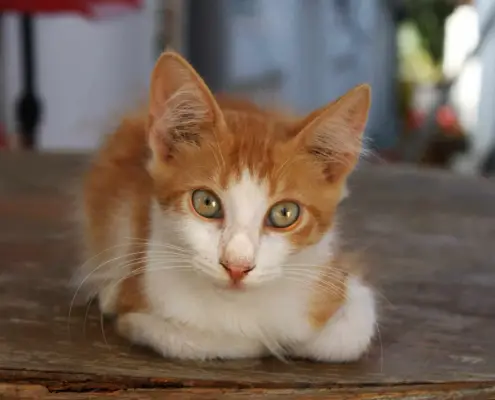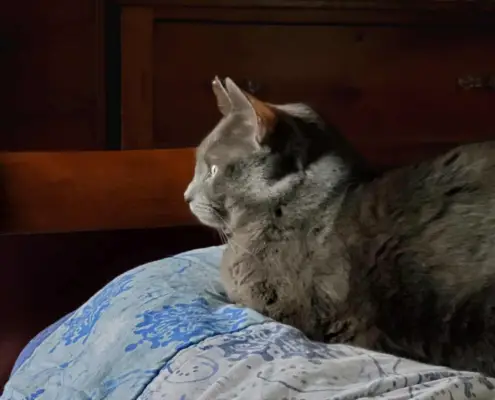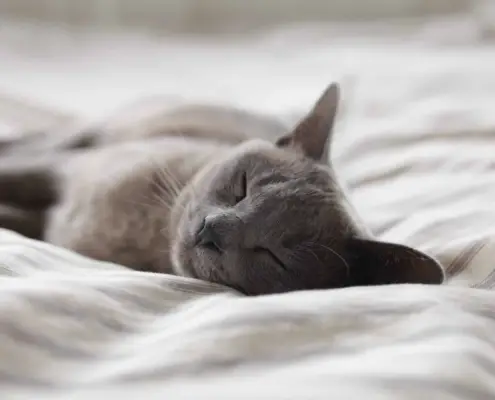
Cats are fascinating creatures known for their unique and sometimes mysterious behavior. One important aspect of their behavior is their body language, which can convey a wealth of information about how they are feeling. Understanding cat body postures is crucial for any cat owner or enthusiast in order to enhance their bond with these furry companions.
Why Understanding Cat Body Language is Important
Being able to interpret a cat’s body language is essential for several reasons. Firstly, it allows us to better understand our feline friends and their needs. Cats are not able to communicate with us through spoken language, so paying attention to their body postures is our key to decoding their messages. By understanding their body language, we can determine if they are feeling content, scared, playful, or even aggressive.
Secondly, understanding cat body language can help prevent misunderstandings and potential conflicts. Misreading a cat’s signals can lead to unwanted interactions or even accidents. By correctly interpreting their body postures, we can adjust our behavior accordingly and provide a safe and comfortable environment for our cats.
Lastly, understanding cat body language can deepen the bond between humans and cats. When we are able to accurately interpret their signals, we can respond to their needs in a timely and appropriate manner. This builds trust and strengthens the bond between us, leading to a happier and more fulfilling relationship.
The Different Types of Cat Body Postures
Cat body postures can be grouped into several categories, each indicating a different emotional state or intention. Some common types of cat body postures include:
1. Relaxed and Content
A relaxed and content cat will exhibit open body postures. They will have their bodies stretched out, with their tail either straight or gently curved. Their ears will be in a neutral position, neither forward nor backward. Their eyes will be partially or fully closed, indicating a sense of comfort and relaxation.
2. Defensive and Fearful
When a cat feels threatened or fearful, they may adopt defensive body postures. These include arching their back, raising their fur, and tucking their tail close to their body. Their ears will be flattened against their head, and their pupils may be dilated. They may also hiss or growl as a warning sign.
3. Aggressive
An aggressive cat will display more assertive and dominant body postures. They may puff up their fur to appear larger, hold their tail upright and rigid, and have their ears pointed forward. Their eyes may appear intense and focused, and they may growl or yowl to intimidate their perceived threat.
What Do Different Cat Body Postures Mean?
Understanding the meaning behind different cat body postures is crucial for interpreting their messages accurately. Here are some common cat body postures and their interpretations:
1. Tail Positions
A cat’s tail position can indicate their mood or intention. A high, straight tail signifies confidence and a friendly approach. A low or tucked tail indicates fear or submission. A tail held straight up with a curve at the end is a sign of curiosity or playfulness.
2. Ear Positions
The position of a cat’s ears can reveal a lot about their emotions. Ears held forward indicate attentiveness and interest. Ears flattened against the head suggest fear or aggression. Ears swiveling or twitching can show a cat’s alertness to their surroundings.
3. Eye Expressions
Cats communicate a great deal through their eyes. Wide-open eyes with dilated pupils can indicate fear or excitement. Half-closed eyes or slow blinks are signs of relaxation and trust. Staring with narrow pupils may be a sign of aggression or a challenge.
It’s important to remember that interpreting cat body language should not rely on a single posture or signal. It is crucial to consider the context, the cat’s overall behavior, and any accompanying vocalizations to accurately understand their message.
Common Cat Body Postures and Their Interpretations
Understanding common cat body postures can help cat owners and enthusiasts recognize and respond appropriately to their feline companion’s needs. Here are some of the most common cat body postures and their interpretations:
1. The “Happy Cat” Posture
When a cat is feeling content and relaxed, they may adopt the classic “happy cat” posture. They will have their body stretched out, lying on their side or back. Their tail will be relaxed, and their eyes may be partially closed. This posture indicates that the cat is feeling comfortable and at ease.
2. The Defensive Posture
A defensive cat will try to make itself appear larger to ward off potential threats. They will arch their back, raise their fur, and may hiss or growl. Their tail may be puffed up, and their ears will be flattened against their head. This posture indicates that the cat feels threatened and is preparing to defend itself if necessary.
3. The Playful Posture
When a cat is in a playful mood, they will exhibit specific body postures. They may crouch down with their front legs extended, their hindquarters raised in the air, and their tail twitching. Their ears will be forward, and their eyes will be bright and focused. This posture indicates that the cat is ready to engage in play and is inviting interaction.
How to Interpret a Cat’s Body Language Accurately
Interpreting a cat’s body language accurately requires observation and understanding of their individual behaviors. Here are some tips to help you interpret your cat’s body language more accurately:
1. Observe Their Overall Behavior
Take note of your cat’s overall behavior and body language in different situations. Pay attention to how they react to certain triggers, such as loud noises or unfamiliar people. This will help you establish a baseline for their normal behavior and recognize any changes or deviations.
2. Consider the Context
The context in which a cat exhibits a certain body posture is essential for accurate interpretation. For example, a cat with a raised tail may be expressing curiosity or playfulness in one situation, but it could indicate aggression in another. Consider the environment, the presence of other animals or people, and any recent changes that may be affecting your cat’s behavior.
3. Look for Consistency
Consistency is key when interpreting cat body language. Look for patterns in your cat’s behavior and body postures. If they consistently exhibit certain signals before engaging in a specific behavior, it can help you anticipate their intentions and respond accordingly.
Tips for Improving Communication with Your Cat Through Body Language
Enhancing communication with your cat through body language requires patience, observation, and understanding. Here are some tips to help you improve your communication with your feline friend:
1. Spend Quality Time Together
The more time you spend with your cat, the better you will understand their unique body language. Engage in interactive play sessions, grooming sessions, or simply spend quiet time together. This will help you build a stronger bond and develop a deeper understanding of their individual body language cues.
2. Respect Their Boundaries
Cats have their own boundaries and preferences when it comes to physical contact. Respect their personal space and avoid forcing them into interactions they are not comfortable with. Pay attention to their body language, and if they show signs of discomfort or withdrawal, give them space and time to relax.
3. Learn from Your Cat’s Reactions
Observe how your cat reacts to different stimuli or situations. If they consistently exhibit certain body postures before becoming anxious or stressed, try to identify the triggers and minimize their exposure to them. By learning from their reactions, you can create a more comfortable and stress-free environment for your cat.
Misconceptions about Cat Body Language Debunked
There are several misconceptions about cat body language that need to be debunked in order to understand them better. Here are a few common misconceptions:
1. A Wagging Tail Means a Happy Cat
Contrary to popular belief, a wagging tail does not always indicate a happy cat. While a dog’s wagging tail is usually a sign of joy, a cat’s wagging tail can indicate agitation, fear, or even aggression. It’s important to consider the overall body language and the context in which the tail is wagging to accurately interpret a cat’s emotional state.
2. A Purring Cat is Always Content
While purring is often associated with contentment, cats can also purr when they are stressed, anxious, or in pain. It’s crucial to consider other body language cues and the cat’s overall behavior to determine their emotional state accurately.
3. A Cat’s Meow Always Means They Want Something
While cats do use vocalizations to communicate, a meow does not always indicate a specific need or desire. Cats may meow for various reasons, including seeking attention, expressing frustration, or signaling discomfort. It’s important to pay attention to their body language and the context in which the meowing occurs to understand their message better.
Understanding Cat Body Language in Different Contexts
Cat body language can vary depending on the context or situation. Here are some common contexts in which understanding cat body language is particularly important:
1. Playtime
During playtime, cats may exhibit specific body postures to indicate their playful intent. They may crouch low to the ground, wag their tails, and pounce on toys or other objects. Understanding these playful body postures will help you engage in interactive play sessions and provide appropriate toys and stimuli for your cat’s enjoyment.
2. Aggression and Fear
Aggressive and fearful body postures are crucial to recognize in order to prevent potential conflicts or accidents. Cats may adopt defensive postures, such as arching their back, hissing, or swatting, when they feel threatened. It’s important to give them space and avoid triggering further aggression.
3. Fear and Anxiety
Cats may display specific body postures when they are feeling fearful or anxious. They may crouch low to the ground, with their ears flattened and their tail tucked. They may also try to hide or retreat to a safe place. Recognizing these body postures will help you create a calm and secure environment for your cat.
Enhancing Your Bond with Your Feline Friend Through Body Language Understanding
Understanding cat body postures is a valuable skill for any cat owner or enthusiast. By decoding their body language, we can gain insight into their emotions, needs, and intentions. This understanding allows us to provide a safe and comfortable environment for our cats, prevent misunderstandings and conflicts, and deepen our bond with these magnificent creatures.
By observing and interpreting their body language accurately, we can communicate more effectively with our feline friends. This leads to a stronger and more fulfilling relationship, based on trust, understanding, and mutual respect. So next time you interact with your cat, pay attention to their body postures and let their silent language guide you towards a deeper connection.
If you enjoyed my article, I would appreciate you sharing it with your network.

Sima Ndlebe
Sima writes for CatBuzz. He is interested in Cats, Health and Fitness, and Entrepreneurship.
Published: 16 November 2023



